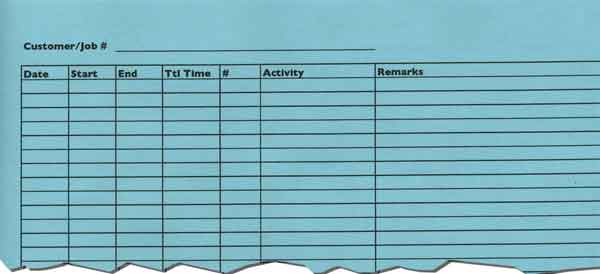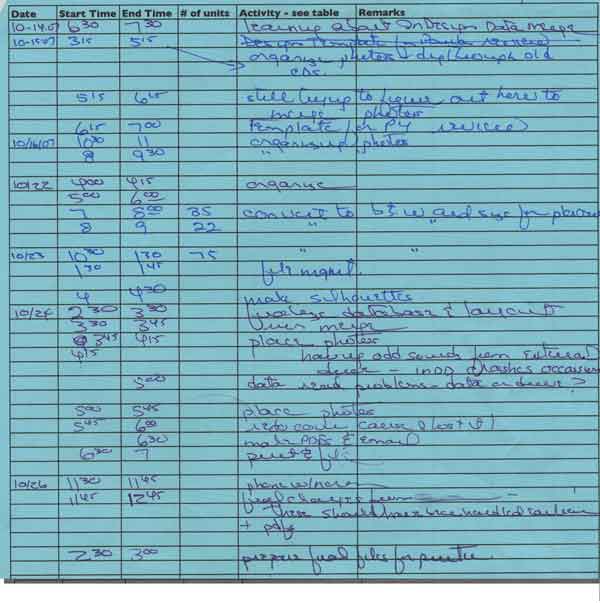I just spent most of a gorgeous Sunday afternoon figuring out how much time a project actually took compared to the proposal estimate. That part was easy: twice as long. Gulp!
Now the more difficult question: how much of this was “beyond scope” and can be billed, how much was attributable to poor estimating on my part, how much was “stupid time”, and how much was that pesky overhead—backing up files, paperwork, phone calls, filing, etc—that doesn’t evaporate just because it gets left out of the initial estimate.
My system isn’t pretty, but I do have everything I need to answer these questions. I am always surprised at the number of people—newbies but also those with some jobs under their belt—who do not track their time.
So for those of you who keep good records, kudos to you. The rest of this discussion will be pretty elementary so you may be excused. As for the rest of you, are you kidding me?!? How do you expect to be profitable if you have no idea how long various parts of a job take?
There are a number of useful online systems, and I’ll write about them in a future post, but I have found the path of least resistance for me is to start with paper. Here is the form I’ve been using for over five years. It gives me room to make notes to myself and I don’t need to decide right away what category a particular activity should be assigned to. I make 50 copies and slip a note into the pile where there are only 10 left to remind me to make more copies. I print it on blue paper so it is easy to spot in my job jacket or on my desk.

As soon as I start a project—even a proposal—I record every moment of my time attributable to that project. And each time I begin work on the project I pull out my timesheet and enter the date and start time. When I am interrupted or complete a discrete task, I enter the stop time. If there is some measurable quantity to track—images scanned or enhanced, pages laid out, etc—I enter that number as well.
I make notations as I go something like: “beyond scope-billable”, “beyond scope-no charge”, “beyond scope?”. I track my “stupid time”: misplacing files [paper or digital], updating the wrong version, running out of ink and having to make an hour long trek to the office supply center.
I note “training time”. This is usually not billable [unless the client specifically asked me to learn and use a new program or technique] but I might want to track it as general overhead. I try on every project to learn one or two new things about my software or other technical issues.
While it’s fresh in my mind, I make notes describing problems and what to do differently next time. In sorting the time in this latest project between “beyond scope” and “client-requested revisions”, it became clear that I needed to use a more formal sign-off procedure so the client and I have a clear understanding of the time and costs related to changes and who will be paying for them. In the long run, that should reduce the seemingly endless revision cycles.
One of the things I learn when I go over my raw notes is that there are ripples generated when I don’t get all the materials on time or things are changed on the fly. It’s not just the time it takes to replace text or swap out photos. It’s also the time involved to create another .pdf or print another review copy. It’s the time it takes to correctly integrate new photos into the current image inventory. It’s the time it takes to recheck and correct new errors and glitches introduced when your carefully planned pagination falls apart because of text changes that lengthen or shorten paragraphs.
Here is a sample of a filled out timesheet that includes some learning time, a lot more time organizing images than I anticipated, some stupid time, hardware acting up time, and some tardy revisions from the client.

There’s also the time it takes to upload .pdfs, burn DVDs, prepare shipping envelopes, run them by FedEx, etc. Most of this is overhead and normally isn’t billed to the client, but it’s part of the time involved in a project that needs to be accounted for.
Once I have the time data recorded on my sheet, the next step is to enter it into a program that helps me track and make sense of it. I have used Excel, QuickBooks, Freshbooks and am now trying Freckle and will write more about that in a future post.
P.S. I also think it’s a really good idea to keep timesheets for everything, not just billable work. This would include reading and writing blogs, filing, researching and preparing workshops and teleclasses, strategic planning, bookkeeping, networking, running business errands, etc. But since I have not taken up this practice, I won’t nag you about it—yet. Please feel free to lord it over me if you are already doing this and tell me how it’s going for you.
See Time Tracking: What Are the Numbers Telling You? for more on how to make sense of all this data.
You might also find my upcoming webinars on money matters and workflow helpful.



3 Comments